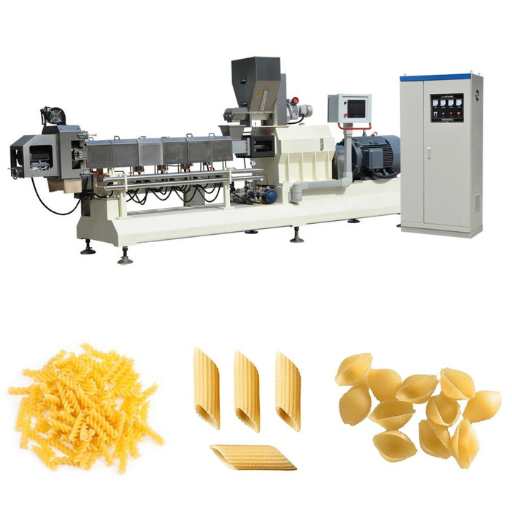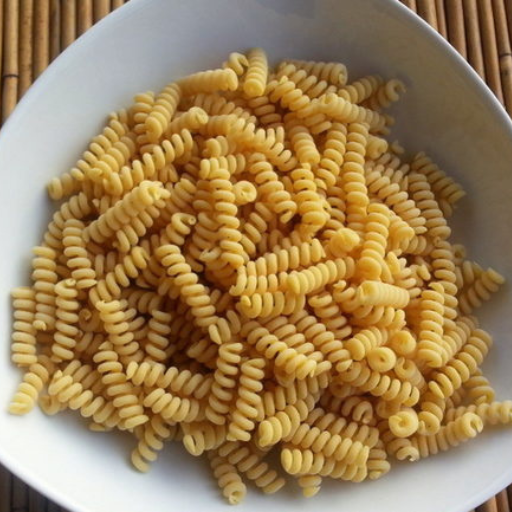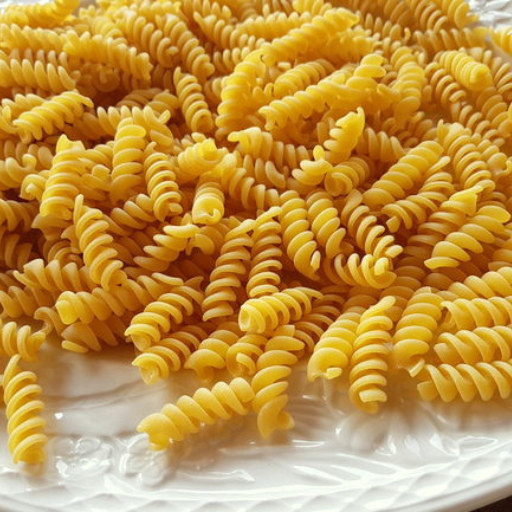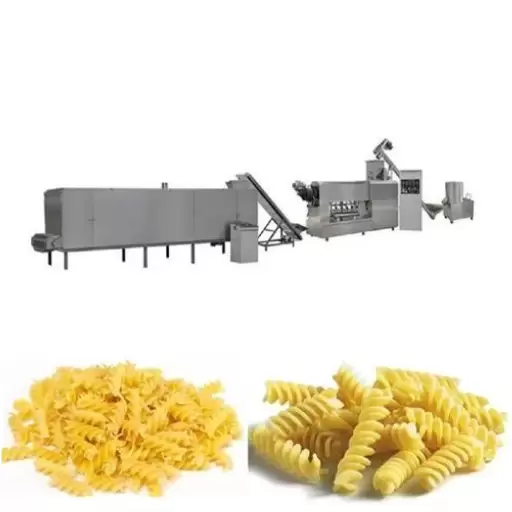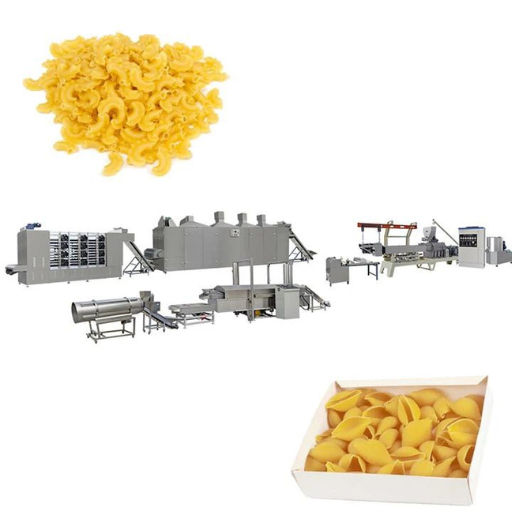In today’s competitive food industry, efficiency and quality are paramount for success. This blog aims to provide you with a comprehensive understanding of how a top-notch macaroni production machine can revolutionize your pasta production process. From enhancing productivity and ensuring consistent quality to reducing operational costs, a state-of-the-art macaroni production machine offers numerous benefits that can take your pasta manufacturing to the next level. Whether you are a small business looking to scale up or an established manufacturer aiming to optimize your production line, this article will guide you through the key features, advantages, and considerations of investing in a high-quality macaroni production machine.
Choosing the Best Macaroni Making Machine for Your Business
Comparing Automatic vs Manual Macaroni Machines
Choosing between an automatic and a manual macaroni machine involves several important factors. Automatic macaroni machines are intended to speed up the production process with little human effort needed for stable production. They have advanced features such as program setting and high speed production that make them best suited for businesses targeting huge amounts of macaroni within the shortest time possible. Conversely, manual macaroni machines are more cost-effective but require a lot of hands-on labor and have lower production volumes. They fit small-scale operations or artisanal pasta makers who value expertise rather than quantity. In conclusion, it depends on your business size, production goals, and budget constraints. Scalable businesses wishing to penetrate wider markets might find it profitable to invest in automatic equipment which can be expensive in the short run while small enterprises or niche producers may prefer flexible machine options with low upfront costs.
Key Features to Look for in a Macaroni Extruder
When choosing a macaroni extruder, there are some main aspects that will significantly affect its efficiency in terms of production and quality of output you need to consider first. First is getting an extruder having top quality dies system; this is because the shape and uniformity of pasta highly depend on these parts which should therefore manage great pressure over time.
Also important is knowing how much you want to produce with this particular extruder as well as its throughput capacity so that you do not compromise on quality when scaling up your company’s activities. For instance, large-scale operations benefit from high-capacity extruders while at the same time smaller ones would be ideal for artisans involved in homestyle or boutique type manufacturing.
Another crucial aspect is temperature control systems put in place by different manufacturers. Consistency during the stage of extrusion implies evenness on texture as well as cooking characteristics among other attributes found in final products hence efficient machines have programmable temperature settings thus allowing higher control and repeatability in the process.
The ease of cleaning and maintenance should also be considered. Cleaning time can be shortened by machines having detachable parts that are easily accessible. Also units made of stainless steel usually last longer and offer better hygiene.
Finally, look at the machine’s energy efficiency as well as operational costs. To save on overhead expenses such as electricity bills, some equipment manufacturers have designed low-power consuming devices hence making them environmentally friendly. Thus, investment in modern high-quality industrial pasta machinery will enhance production efficiency and reduce cost.
Understanding the Impact of Industrial Pasta Machinery on Production Efficiency
Industrial pasta machinery significantly enhances production efficiency through various means. Automating tasks that were previously done manually through these machines consequently increases output while reducing labor costs in the process. Consistency is a major concern when it comes to ensuring quality in a pasta product this can be achieved through advanced features like programmable settings and precise temperature control which minimize waste leading to uniformity across all final products. Processing huge amounts of pasta quickly not only meets demand but maximizes factory’s productivity as well. Furthermore, energy efficient machinery cuts down operating costs thereby increasing general effectiveness.Investing in modern high quality industrial pasta machinery could therefore bring about substantial improvements in production efficiency and cost-effectiveness too .
Setting Up Your Macaroni Production Line
Basic Elements of a Pasta Production Line
Many critical parts contribute to the success and quality of macaroni made during production. Here are the key ones:
- Dough Mixer: This machine, which also adds water into semolina to make dough with proper consistency and moisture content for subsequent operations.
- Extruder: The extrusion method shapes the dough when it is being pushed through dies that can come out as macaronis among other types of pasta. It is important to have adjustable settings for different pasta types and thicknesses in extruders.
- Dryer: After extrusion, pasta must be dried to contain appropriate moisture levels that will enhance shelf life while retaining product quality. Dryers should have very accurate temperature and humidity control capabilities so as not to spoil or over-dry.
- Cooling System: Post-drying, the pasta needs to be cooled gradually to prevent cracks or breakage. Cooling conveyors or chambers help slowly bring the pasta down to room temperature safely.
- Packaging Machine: Finally, packaging machines are necessary for bagging or boxing dried pasta ready for distribution. Packaging options that maximize storage space on shelves while prolonging useful life are critical as they alleviate transportation costs too.
Putting all these components together will streamline your macaroni production line leading to increased productivity and product uniformity.
Integrating Dryer Systems for Optimal Pasta Drying
Macaroni production lines need dryer systems integrated in them in order to achieve their desired moisture contents thus ensuring that their end products meet certain qualities required. To optimize pasta drying, consider the following aspects based on industry best practices:
- Temperature Control: High-precision temperature control is necessary so that no cracks are formed on pasta texture deterioration; therefore modern drying systems employ staged drying processes where temperatures progressively change during moisture evaporation.
- Humidity Management: Throughout the drying process, it is essential maintaining optimum humidity rates since this helps retain structural integrity of pasta avoiding its brittleness. The advanced drying appliances have sensors and controls that monitor & adjust humidity in real-time.
- Airflow and Ventilation: Uniform airflow and proper ventilation are crucial in ensuring consistent drying. Systems with adjustable airflow mechanisms ensure that all pasta pieces dry at the same rate, avoiding under or over-drying.
By focusing on these elements, you can integrate dryer systems effectively into your production line, leading to superior product quality and operational efficiency.
Customizing Your Production Line for Different Pasta Types
Customizing your production line for different pasta types involves tailoring equipment and processes to meet the specific needs of each variety. Here are key aspects to consider:
- Extrusion Dies and Molds: Each pasta shape has a unique extrusion die and mold. Buy different quality dies which will enable you to produce diversified pasta types ranging from long strands like spaghetti to complicated shapes such as fusilli or farfalle.
- Mixing and Kneading: Change the mixing/kneading process based on the type of pasta one is making. For example, durum wheat semolina is good for traditional Italian pastas while other flours may be used for specialty or gluten-free products. Also it is important to achieve optimal textures as well as qualities through correct hydration of dough.
- Drying Parameters: Customize drying parameters such as temperature, humidity, and drying time based on the pasta type. Various pasta sizes require different moisture contents since some become hard after they dry hence they need time then others because of their size differences in order them not to crack during cooking sessions.
- Cooking and Quality Testing: Carry out particular cooking tests and quality control measures for each type of pasta that would create uniformity in texture, flavor, and appearance. Regularly monitor and adjust production parameters based on test results to maintain high standards.
The focus on these customization elements will enable you to optimize your production line to efficiently produce a wide variety of pasta while maintaining quality and consistency.
Operating Your Pasta Making Machine for Maximum Output
Pasta Extruder Maintenance: A Guide to Best Practices
To lengthen the life and ensure better service of your pasta extruder machine, proper maintenance is crucial. Here are some best practices and technical parameters that will help you in this:
- Regular Cleaning: For every production run, make sure to clean it thoroughly. This helps prevent hardening of dough remnants and machine clogging that might affect pasta quality alongside its operation.
- Technical Parameters: Use warm water with a food-safe detergent. During cleaning, remove parts such as the cutter and die for a more thorough wash where no remnants are left.
- Lubrication: Lubricate moving parts regularly to reduce wear and tear which also maintains smooth running conditions while preventing breakages.
- Technical Parameters: Employ food-grade lubricants while following the manufacturer’s schedule of about every 100 hours of operation.
- Inspection and Replacement: Regularly check all components for wear or damage. Quickly replace any worn out parts because they can degrade performance or the quality of pasta produced.
- Technical Parameters: Perform inspections after every 200 hours of machine operation as well as maintain logs on maintenance. The main components under scrutiny are cutting blades, die and extrusion screw.
- Calibration: Calibrating your machine will ensure even pressure during extrusion hence uniform shapes and sizes of pasta.
- Technical Parameters: Adjust the settings according to manufacturer’s specifications usually done during monthly maintenance checks.
- Temperature Management: Monitor the working temperature range to avoid overheating that may harm your machines.
- Technical Parameters : Normally recommended operating temperatures range between 20°C -25°C while using thermal sensors to monitor temperature continuously for your machine.
- Preventive Maintenance : Follow preventive maintenance schedules based on manufacturers’ recommendations in order to avoid expensive repairs, prolonged downtimes or other issues that can arise later on if not addressed early enough.
- Technical Parameters : Observe preventive protocol an hour’s worth 500-hour operational cycle by undertaking comprehensive checks on all electrical systems, motor performance and mechanical integrity.
By following these guidelines and observing the indicated technicalities, you will be running an efficient pasta extruder which constantly produces high-quality pasta.
Pasta Maker Machines Troubleshooting: Common Issues
Users of pasta maker machines may experience some common challenges. Here is a guide with how to address them:
Machine Jamming or Clogging:
- Possible Cause : Overloading the machine with pasta dough or using dough that is too wet or too dry.
- Solution: The dough should neither be crumbly nor sticky while feeding it bit by bit into the machine and cleaning its extruder and cutting blades more regularly to avoid build up of dirt.
Inconsistent Pasta Shape and Size:
- Possible Cause : Machine calibration was wrong or extrusion dies are worn out.
- Solution : For uniformity in shapes and sizes of pasta recalibrate your machine according to manufacturer’s specifications. Ensure that you inspect worn-out dies for replacement purposes.
Overheating :
- Possible Cause : Continuous operation without adequate breaks or operating in a non-ventilated area.
- Solution : To avoid overheating, use thermal sensors to monitor your machine’s temperature as well as provide cooling time between long cycles; also make sure there is enough ventilation in your working place to dissipate heat effectively.
By acting on these issues immediately, you can maintain the efficiency and longevity of your pasta making machine so that it consistently produces top-quality noodles.
Increasing Efficiency Using Automatic Pasta Makers
Automatic pasta makers are very useful in households’ kitchens as well as restaurants where they serve a large number of customers. Some significant ways through which one can get the most from such gadgets have been provided based on various sources.
- Consistent Output: Automatic pasta manufacturers create dough and pasta shapes at the same rate without any human intervention. This uniformity means that every batch is good-quality, thus limiting wastage and reworking. Therefore, these machines enable big orders to be met on time by maintaining a constant flow of production.
- Time Savings: This implies that hours spent before in kneading, rolling, cutting can now take a few minutes through this automation. By doing so, the amount of time that chefs spend on other culinary skills will go high hence improving the productivity of the whole kitchen.
- Ease of Use: Most automatic pasta makers nowadays are designed with user-friendly interfaces and settings for different types of pasta. With only a little training, your kitchen staff may be able to run them efficiently thereby reducing downtime and mistakes.
- Reduced Labour Costs: Automation in pasta making has therefore helped companies lower labor expenses. Additionally, less personnel is required to oversee as well as manually produce pasta freeing them up for other important duties.
- Versatility: These machines can make different shapes of pasta at once so that they suit different consumers. Thus you will have an opportunity to increase your menu while using the existing equipment.
Through use of these benefits, automatic pasta makers allow chefs to increase their output by ensuring consistent quality control during pizza preparation process leading to improved efficiency and performance levels without compromising on food safety standards.
Exploring the Variety of Pasta You Can Produce
Making Pasta Shells and Long Pasta with Your Machine
When preparing shell pasta and long pasta with your machine, there are several crucial steps to adhere to so as to obtain the best results:
- Mixing the Dough: First, make a high-quality dough. Traditional Italian pasta with 00 flour and eggs in it should neither be too dry nor too sticky. This is possible if your machine can mix them properly.
- Adjusting Device: For shell pasta, fix the right die or mold on your appliance. It shapes the dough into the necessary shell form: conchiglie, lumache, conchiglioni. To get long noodles like spaghetti or fettuccine use special cutter or extrusion settings.
- Setting Thickness: Set your machine’s thickness according to what kind of pasta you want to make. Shell noodles will need slightly thicker dough than long ones that should be thin and subtle.
- Extrusion Process: The dough must flow through the device at a steady pace without breaking or changing the shape for which it has been intended during its production process – shells in case of shell pasta;—and sometimes for long pasta which creates continuous strands.
- Drying and Cooking: Once extruded let this product dry a little bit before cooking until desired texture is reached. It helps retain their shape when you do it for shell pastas, while for long ones, clumping does not occur during boiling.
By following these steps, your automatic pasta maker will consistently produce first-rate quality shell and long pastas; hence making cooking enjoyable with minimum effort required from you and maximum efficiency guaranteed.
Expanding Your Scope – Moving Beyond Macaroni
To give wider options in making different types of our favorite Italian food we only have to change our devices’ settings & accessories depending on types of macaroni. For macaroni insert a tube extrusion die & cut off as required lengthwise; choose an elongated thin die for spaghetti as well as press out evenly distributed dough pieces to achieve identical strands. Ensure manufacturers’ recommendations on mix quality are followed and pasta has dried a little before cooking. This enables you to make effortless changes in pasta shapes or textures, thus enabling you to have authentic Italian cuisine at home.
Customization of Pasta Shapes and Sizes
One of the features which distinguishes an automatic pasta maker is its ability enable users to make several different shapes and sizes of pasta in line with their preferences. Today’s models often include various dies and attachments that can produce different forms like fettuccine penne lasagna sheets etc. Thus, by just changing these accessories, one can easily cook different types of pasta without changing its texture or shape. Moreover, some sophisticated devices allow you to adjust length and thickness via program settings hence providing precise control over your end product. This means that whether it is a strong-willed lasagne or an ethereal capellini, your machine will be equal to this task producing the same consistent good results all the time.
Investing in a Pasta Maker: Considerations and Cost Analysis
Understanding the Range of Prices for Pasta Machines
Having delved into what different pasta machines cost, I discovered that depending on the kind, features and brand, their prices can vary greatly. After consulting the top sources in this field, it appears that manual pasta makers are usually valued between 30 and 80 dollars. They have simple designs and are based on hand-cranking technology. At the same time electric makers offer convenience with additional options like automatic mixing as well as extrusion can be sold at a price of $100-$300 or even more. On the other side high-end models which consist of advanced settings and some different attachments for various types of pasta could end up being around $500 or even more. Therefore, your choice will depend on your budget as well as how often you plan to use them and how convenient you want to be.
The ROI Calculation for Your Macaroni Maker
Several factors come into play when calculating return on investment (ROI) in regards to your macaroni maker. Firstly, factor in the initial price of the machine against buying store-bought pasta over an extended period. For instance if I were to purchase an electric pasta maker at $200 whereas a box of past goes by $5 weekly, within less than one year I would have recouped my money if I made similar volumes from home instead. Additionally with homemade versions, very often they taste better besides allowing us make healthier ingredient choices thus adding to its overall value. Moreover intangible benefits like time saved using an electric model plus self-satisfaction while cooking fresh noodles or reason such as entertaining visitors or giving friends gifts also contribute towards better ROI results out there online according to best known sources. According to insights from reputable online sources though any person who loves preparing pasta should invest in a proper quality maker he can definitely save through buying one.
Why Good-Quality Stainless Steel Equipment Is Worth Paying More For
Beyond the immediate expense of buying, there are other advantages attached to the investment in high-quality stainless steel equipment. First and foremost, stainless steel machines have unmatched durability and last for a long time. For example, it is very resistant to getting rusted or corroded so it can be used for a long time even in kitchen conditions. Additionally, this material does not demand much effort in cleaning it thus saving both time and improving hygiene level important in food preparation processes. Furthermore many sources mention that stainless steel looks good, making it appear professional as well as modern in any kitchen space. Therefore those who are passionate about cooking should definitely think about acquiring high-quality stainless steel equipment which combines functionality with durability and style.
Reference sources
-
Taste of Home: The Best Pasta Maker of 2024, Tested and Reviewed
-
Epicurious: Best Pasta Makers (2024), Tested and Reviewed
-
Serious Eats: The 3 Best Pasta Extruders of 2024, Tested & Reviewed
- Serious Eats reviews the best pasta extruders of 2024, focusing on models like the Philips Viva Collection Compact Pasta and Noodle Maker. This guide covers the functionality and efficiency of these machines, making it a key reference for selecting top-notch macaroni production equipment.
- Read More3
Frequently Asked Questions (FAQs)
Q: What are the main characteristics of a good macaroni pasta making machine?
- High production capacity, strong structure, efficient energy consumption, versatility in the production of different shapes of macarons are some of the features a good macaroni machine should have. Additionally an automatic macaroni machine and ease in cleaning and maintenance are necessary for such machines to support commercial operations. Most often successfully integrating such features is KP Automations.
Q: How does an extruder pasta machine contribute to pasta factory efficiency?
- The process of making pasta more efficient in a pasta factory is facilitated by use of an extruder pasta machine which avoids complexities that come with it. This mechanization mixes the dough, kneads it and extrudes the paste through specific dies that can give various types at high speeds. In addition this mechanization helps to maintain even quality of pasta and lower cost of labor.
Q: Can electric industrial pasta machines handle both macaroni and spaghetti production?
- Yes, electric industrial machines for producing Spaghetti as well as Macaroni exist; they come with interchangeable dies and settings which can be adjusted to produce diversified shapes of pastas depending on the market demand.
Q: What is the importance of the packing machine in pasta production lines?
- The role played by packaging machine during this phase cannot be underestimated since it enables to prolonging shelf-life while maintaining its hygiene standards. It also weighs correctly and seals them before distribution or presentation purposes as required by professionals only to ensure there is no discrepancy in product quality during transportation or storage.
Q: How does making machine price affect the setup of new pasta plants?
- The new investment cost for most plants depends on how much you will spend on buying these machines since they take up a significant portion from all costs incurred initially. Cutting down on expenses at start-up can be achieved by getting affordable but quality machinery for producing Pasta. When buying these machines, one should look for a balance between cost savings or reduced prices and product reliability as well as durability. KP Automations often suggests these attributes.
Q: Are there specific machines designed for the Italian pasta-making process?
- These are called spaghetti makers or pasta macaroni spaghetti machines that are specifically meant to make the traditional Italian pastas. The temperature and drying times in such machines have specialized dies which ensure that this traditional method produces high quality Italian pasta.












